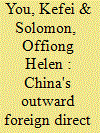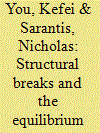| Srl | Item |
| 1 |
ID:
143424


|
|
|
|
|
| Summary/Abstract |
In the past decade, China's outward foreign direct investment (FDI) has increased significantly. On the other hand, the Chinese economic growth model is heavily reliant on domestic investment. Our study examines the important issue of how China's domestic investment responds to its FDI outflows. We investigate this issue analyzing, for the first time, China's domestic investment at industrial level. We specifically account for the factor of government support given the significant role played by the state in the Chinese economy. Using industrial level data, we further evaluate whether domestic investment reacts to outward FDI differently between state dominated and non-state dominated industries. Our study adopts an accelerator model where the system-Generalized Method of Moments (GMM) is employed for our estimations. Our empirical results suggest that domestic investment responds positively to outward FDI in China, Furthermore, the FDI outflows influences domestic investment differently depending on the level of government support in the particular industries. Such influence is much stronger in state dominated industries than in the non-state dominated ones.
|
|
|
|
|
|
|
|
|
|
|
|
|
|
|
|
| 2 |
ID:
116534


|
|
|
|
|
| Publication |
2012.
|
| Summary/Abstract |
This paper investigates the equilibrium real effective exchange rate for the Chinese RMB during the post-reform period, 1982-2010. We extend the NATREX model in several important perspectives and apply it for the first time to China. A wide range of economic fundamentals that are unique to the Chinese economy is introduced into the model. We construct a unique set of quarterly data and employ unit root and cointegration tests that can account for multiple endogenous structural breaks. In addition, to capture the evolution of China's foreign trade pattern, we employ time-varying (i.e. 3-year average) trade weights to construct the real effective exchange rate. We find two structural breaks in the cointegration relationship (in 1988 and 1992). Effective terms of trade, demographic factors, liquidity constraints and government investment are significant determinants of the equilibrium real effective exchange rate. The RMB was overvalued against a basket of 14 currencies until mid-1980s. During 1986-2010, it was undervalued in most years except after the Asian financial crisis in 1997. We have found persistent undervaluation from 2004 onwards. However, the misalignment rates are much lower than those reported by previous studies and the undervaluation rate actually declined sharply in 2008. The undervaluation rate rose modestly in 2009 and sharply in 2010, though it is still lower than what has been suggested by other studies.
|
|
|
|
|
|
|
|
|
|
|
|
|
|
|
|